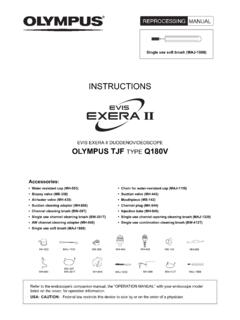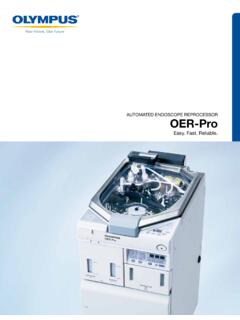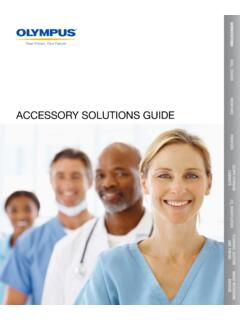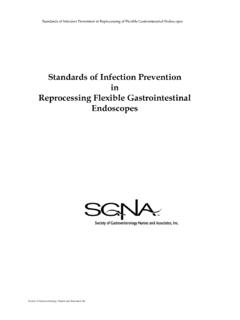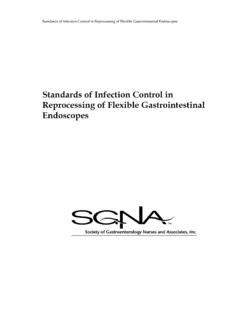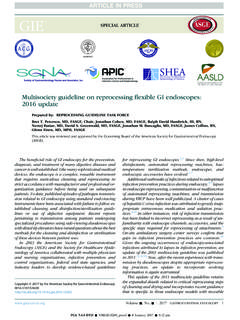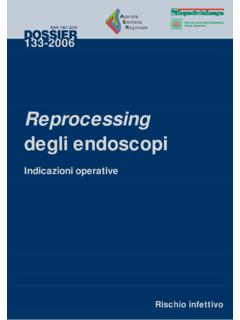Transcription of Instrument Reprocessing Flexible Endoscopes - …
1 Instrument Care Reprocessing Flexible Endoscopes Avoiding Reprocessing Errors Critical for Infection Prevention and Control By Bradley Catalone, , and George Koos F. lexible endoscopy proce- errors commonly identified in dures are now a routine hospitals and surgery centers in the part of patient diagnosis United States and discusses how and treatment in hospitals and surgery these can be avoided. centers in the United States. The demand for these safe and effective Pre-cleaning procedures continues to increase, Pre-cleaning is an essential with more than 15 million endoscopy Reprocessing step that removes patient procedures annually. Endoscopies are biomaterial and microorganisms performed with sophisticated, reusable, from the endoscope.
2 Following an Flexible instruments that have specific endoscopy, biomaterial from the requirements for cleaning, disinfection patient is present on the insertion tube and sterilization. Because of this, and within the internal channels of adherence to recommended practices the endoscope. All channels must be and guidelines for Reprocessing is cleaned, even if unused, due to fluid a critical component of infection and debris entering these channels at control and reducing the risk of the distal tip. Patient biomaterial nosocomial infections. provides a nutrient source that will Failure to follow established promote the growth of potentially guidelines for Reprocessing has pathogenic microorganisms. Also, resulted in the transmission of when this biomaterial is not removed infectious agents causing serious immediately after a procedure, it will patient injury and/or Despite dry and harden.
3 The surface of the these incidents, concise manufac- hardened material functions as a turer's Reprocessing guidelines, and barrier that prevents the penetration the development and publication of disinfecting and sterilizing agents of several recommended practice and that kill microorganisms. In addition, guidance documents,4-8 appropriate patient biomaterial may inactivate cleaning, disinfection and/or steriliza- disinfectants. The result is potentially tion of Endoscopes continue to be a infectious material still present on challenge for many facilities. This the endoscope or in the endoscope article presents some Reprocessing channels following Reprocessing delays. 74 MANAGING INFECTION CONTROL JUNE 2005. Instrument Care A Reprocessing delay may occur when a patient has both soaked in an appropriate enzymatic detergent according to upper and lower procedures performed during the same visit.
4 The manufacturer's recommendations, before continuing with The endoscope from the first procedure is kept in the procedure mechanical cleaning and then terminal Reprocessing . This room until the second procedure is completed. If pre-cleaning process will allow for any dried debris to be loosened and is not initiated within an hour, the endoscope should be ensure its removal during cleaning. Reprocessing delays may be encountered if staff must come in and perform emergency procedures at night or over If pre-cleaning is not initiated within an the weekend, leaving the endoscope to be properly reprocessed hour, the endoscope should be soaked by the regular staff on the next workday. Delays may also occur in busy departments, especially when cases run longer in an appropriate enzymatic detergent then expected.
5 In the rush to get to the next procedure, the according to the manufacturer's pre-cleaning is often abbreviated or the endoscope is set aside until the next case is finished. The pre-cleaning process is not recommendations, before continuing with a long procedure, but is an essential step in the cleaning mechanical cleaning and then terminal process. Pre-cleaning should be performed every time Reprocessing . This process will allow according to manufacturer's instructions. To avoid additional delays, the endoscope insertion tube for any dried debris to be loosened and should be wiped down and all of the channels flushed with ensure its removal during cleaning. detergent and/or water (as specified by manufactuer's instructions). as soon after the procedure as possible, preferably immediately.
6 76 MANAGING INFECTION CONTROL JUNE 2005. Instrument Care The mechanical action of wiping the endoscope, coupled Submersion with flushing all of the channels, removes biomaterial that A common Reprocessing error is the failure to fully harbors and provides nutrients for microorganisms. When submerge the endoscope in detergent or disinfectant for the delays in pre-cleaning do occur, additional Reprocessing required length of time. Contact time is a critical component to steps, which include an extended soak period, are required. the efficacy of any detergent or disinfectant, especially for the Follow the manufacturer's instructions for delayed repro- disinfectant. Do not guess; use a timer. Anything less than cessing of Endoscopes . the recommended time will not produce a patient-ready.
7 Endoscope. Anything substantially over the recommended time Mechanical Cleaning may lead to endoscope damage. If portions of the endoscope Guidelines from professional organizations are not submerged for the required contact time during consistently state that mechanical cleaning is critical exposure to either the detergent or disinfectant, infectious for proper endoscope Reprocessing . Mechanical cleaning material may remain on the endoscope following Reprocessing . is essential to reducing bioburden and preventing the risk The primary reasons for failure to fully submerge of cross-contamination. Studies indicate that mechanical the endoscope are that the sink/basin is not large enough to cleaning alone reduces bioburden by an average of 4 logs accommodate the Flexible endoscope, or not enough of the ( ).
8 9-10 The Multi-society Guideline for Reprocessing properly diluted detergent or disinfectant was added. The Gastrointestinal Endoscopes5 identifies mechanical recommended sink/basin should be at least 16 inches by 16. cleaning as essential before manual or automated inches by 8 inches. After placing the endoscope in the disinfection, and the guideline categorizes cleaning sink/basin, ensure that the scope is fully submerged. If not, add as a Class 1A recommendation, the strongest possible additional properly diluted detergent or disinfectant. If using an classification, stating: strongly recommended for imple- automated endoscope reprocessor, follow the manufacturer's mentation and strongly supported by well-designed instructions for loading the endoscope into the basin.
9 Experimental, clinical, or epidemiologic studies.. Mechanical cleaning is a multi-step process that Channel Reprocessing and Cleaning Accessories involves accessories for brushing and flushing the The validated cleaning adapters supplied by the manufacturer endoscope channels and openings. The multitude of are critical for properly Reprocessing the endoscope channels. d e t e rgents, disinfectants, and accessories specific for Some scopes have additional or unique channels, such as an each endoscope may lead to improper cleaning. Some auxiliary water channel (forward water-jet) or elevator wire common areas to focus on include the following: channel, which require Reprocessing . All channels must be Detergent Use cleaned and disinfected even if they are not used during the One of the most common errors during procedure.
10 By not utilizing the correct, validated connection, cleaning is improper dilution of the detergent. there is a high probability that many or all channels will not be The more is better theory may work with some adequately reprocessed. To ensure that all channels are things in life, but detergents and liquid chemical adequately reprocessed, refer to the manufacturer's instruction germicides are not among them. The detergent is manual for scope Reprocessing and, if applicable, contact the formulated to be effective at a specific dilution and automated endoscope reprocessor (AER) manufacturer for the temperature. Any deviation from the instructions for proper cleaning accessories. use may alter the effectiveness of the detergent, its ability to be properly rinsed, and possibly cause Channel Brushing damage to the scope.
